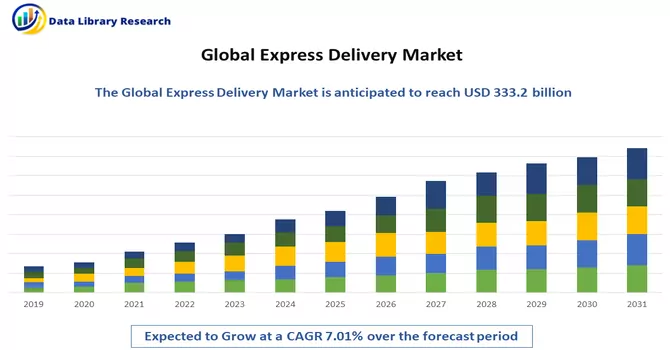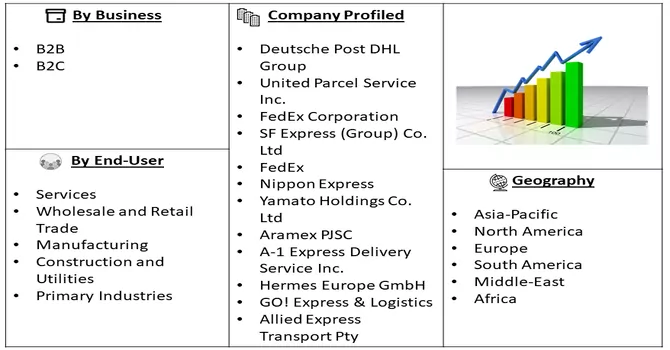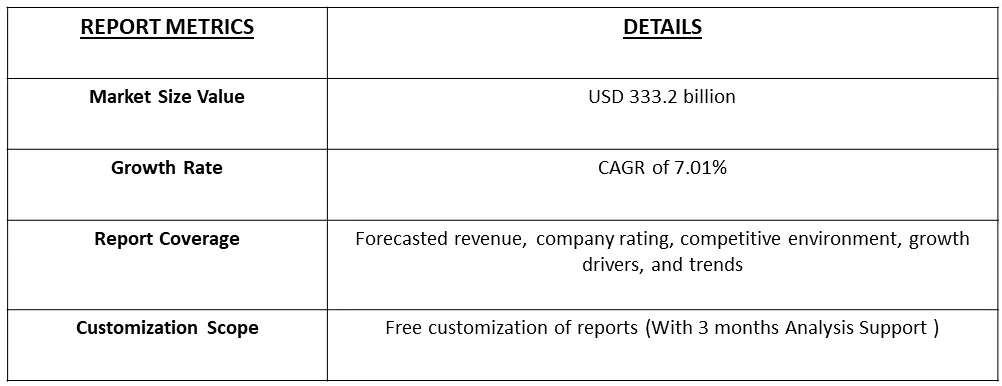The Global Express Delivery Services Market is estimated to be USD 333.2 billion in 2022 and is expected to register a CAGR of 7.01%.

Get Complete Analysis Of The Report - Download Free Sample PDF
Express Delivery Services refer to a comprehensive and expedited transportation and delivery network that operates on an international scale. These services are designed to transport parcels, packages, documents, and goods efficiently and rapidly across borders and between countries. Global express delivery services are characterized by their speed, reliability, and door-to-door delivery capabilities.
The surge in the global express markets is propelled by robust domestic e-commerce sales. Domestic markets are experiencing more rapid growth compared to international markets across various regions, although this discrepancy is notably diminishing in some areas. The distinction between domestic and international markets is less pronounced in North America and Europe, with Europe benefiting from market interconnectedness and lower barriers to international trade.
Domestic markets have adeptly capitalized on the opportunities presented by e-commerce. However, challenges persist for the international market, characterized by higher costs and longer delivery times associated with international parcels. Cross-border e-commerce plays a pivotal role in boosting the international express market, particularly in regions witnessing substantial cross-border e-commerce volumes such as Asia Pacific and Europe.
The continued growth of e-commerce has been a significant driver for express delivery services. The increasing popularity of online shopping, especially cross-border e-commerce, has led to a surge in demand for fast and reliable delivery services globally. The global express delivery industry is influenced by regulatory changes, especially in customs and international trade. Companies are adapting to evolving regulations to ensure compliance and facilitate seamless cross-border shipments. Thus, these trends reflect the evolving landscape of the global express delivery services market, driven by technological advancements, changing consumer expectations, and a dynamic global business environment.
Market Segmentation: The report covers Global Express Delivery Service is segmented by Business (B2B and B2C), End User (Services, Wholesale and Retail Trade, Manufacturing, Construction, and Utilities, and Primary Industries), and Geography (North America, Europe, Asia-Pacific, Middle East and Africa, and South America). The report offers the value (in USD million) for the above segments.

For Detailed Market Segmentation - Download Free Sample PDF
Market Drivers:
Exponential Rise of E-Commerce Worldwide and Rising Globalization
Globalization has facilitated cross-border trade by reducing trade barriers and promoting international cooperation. E-commerce businesses can now reach a global customer base, necessitating efficient and reliable global express delivery services. Moreover, businesses are increasingly looking beyond domestic markets to expand their reach. Global express delivery services enable companies to efficiently ship products internationally, tapping into new markets and customer segments. The economic growth of emerging markets has created new opportunities for global trade. Express delivery services play a crucial role in connecting businesses with consumers in these growing markets, facilitating economic development on a global scale. Thus, the above-mentioned reasons are expected to drive the growth of the studied market over the forecast period.
Innovations in Logistics Technology and Improvements in Customs Processes and Trade Agreements
The innovations in tracking systems, GPS technology, and IoT (Internet of Things) devices have enabled real-time tracking of shipments throughout the entire supply chain. The global express delivery services now provide customers with precise and up-to-the-minute information about the location and status of their shipments, increasing transparency and reducing uncertainties. Also, integrated global trade platforms provide a centralized hub for managing and tracking international shipments. These platforms enhance collaboration among various stakeholders, including shippers, carriers, and customs authorities, leading to more efficient global express delivery operations. The combination of these innovations in logistics technology and improvements in customs processes and trade agreements has ushered in a new era for global express delivery services, enabling them to meet the demands of an increasingly interconnected and fast-paced global economy.
Market Restraints :
Regulatory Landscape and Infrastructure Limitation
Different countries have varying regulations and customs procedures, which can pose challenges for express delivery services. Adhering to diverse regulatory environments adds complexity and can slow down the shipping process. In certain regions, inadequate transportation infrastructure can impede the seamless operation of express delivery services. Poor road networks, congested ports, and limited air cargo capacity can contribute to delays and increased costs. Thus, these factors are expected to slow down the growth of the studied market over the forecast period.
The COVID-19 pandemic has had a profound impact on various industries, including global express delivery services. Lockdowns, travel restrictions, and disruptions to manufacturing and transportation created challenges for global supply chains. With more people staying at home, there was a surge in demand for last-mile delivery services, particularly for residential areas. Also, express delivery services had to adapt to the increased demand for home deliveries, with a focus on optimizing last-mile logistics for efficiency. Express delivery services had to adapt to shifts in trade patterns, including changes in demand for specific regions and adjustments to transportation routes. Thus, the the COVID-19 pandemic presented numerous challenges for global express delivery services, it also underscored the sector's resilience and adaptability. The industry demonstrated its importance in facilitating essential shipments, supporting e-commerce growth, and playing a vital role in the global response to the health crisis.
Segmental Analysis:
Domestic Segment is Expected to Witness Significant growth Over the Forecast Period
Domestic delivery services play a crucial role in the efficient movement of goods within the boundaries of a single country. These services encompass a range of logistics solutions designed to transport packages, parcels, and freight from one location to another within the same nation. Express delivery services are known for their quick transit times, aiming to deliver packages and parcels in the shortest possible duration. Moreover, express delivery services typically offer robust tracking systems that allow customers to monitor the progress of their shipments in real time. Thus, these factors are expected to drive the growth of the studied market over the forecast period.
Services (BFSI (Banking, Financial Services and Insurance)) Segment is Expected to Witness Significant growth Over the Forecast Period
The intersection of the Banking, Financial Services, and Insurance (BFSI) sector with express delivery services reflects a dynamic collaboration aimed at providing efficient and secure solutions for the seamless movement of financial documents, packages, and other assets. xpress delivery services play a role in the secure physical transportation of data storage devices, backup tapes, and other media containing sensitive financial information. Moreover, Express delivery services may collaborate with BFSI institutions to retrieve and deliver customer documents, such as account statements or legal paperwork. Thus, these factors are expected to drive the growth of the studied segment over the forecast period.
Asia-Pacific Region is Expected to Witness Significant growth Over the Forecast Period
The Asia-Pacific region is a dynamic and economically diverse area that has experienced remarkable growth in recent decades. This growth has been fueled by rapid industrialization, technological advancements, and the expansion of e-commerce. As a result, the demand for express delivery services in the Asia-Pacific has surged, transforming the logistics landscape in the region.
The ongoing integration of technology in logistics operations, such as AI, IoT, and blockchain, is expected to shape the future of express delivery. With a diverse landscape encompassing bustling urban centers, sprawling manufacturing hubs, and remote rural areas, the express delivery sector in Asia-Pacific faces the unique challenge of catering to a wide range of geographies. The booming e-commerce industry, driven by a growing middle class and increased internet penetration, has significantly contributed to the surge in demand for swift and reliable express delivery services. Intense competition among both local and global players has led to continuous innovation, strategic partnerships, and the integration of advanced technologies to enhance the efficiency and reliability of deliveries.
As the Asia-Pacific region continues to play a pivotal role in global trade and commerce, the express delivery sector is poised for continued growth, with a focus on addressing challenges such as traffic congestion, sustainability concerns, and the integration of cutting-edge technologies to ensure the seamless movement of goods across this vast and diverse region.

Get Complete Analysis Of The Report - Download Free Sample PDF
The escalating demand for express delivery services in developing nations is prompting companies to intensify their competitiveness to tap into this substantial opportunity. International players are strategically investing in the establishment of regional logistics networks, exemplified by initiatives like inaugurating new distribution centers and implementing smart warehouses. Local companies, in turn, contend with formidable competition from multinational counterparts that boast relatively more advanced infrastructure. Some of the key market players are:
Recent Development:
1 ) February 2021: DHL Express made two additions to its roster of contract carriers that bring with them extra aircraft to help the parcel carrier meet escalating growth in e-commerce shipments. The express delivery arm of postal and logistics giant Deutsche Post DHL Group arranged for German leisure airline Condor and a start-up cargo division of Latvian carrier SmartLynx to fly packages in its European air network.
2 ) July 2020: UPS (an American multinational package delivery and supply chain management company) launched its Saturday delivery service in eight European markets. The launch follows after European consumers have increasingly turned to online shopping during the coronavirus breakout. The UPS Saturday Standard service will launch in the United Kingdom, Germany, France, the Netherlands, Belgium, Italy, Spain, and Poland.
Q1. What was the Express Delivery Market size in 2022?
As per Data Library Research the Express Delivery Services Market is estimated to be USD 333.2 billion in 2022.
Q2. At what CAGR is the Express Delivery Services market projected to grow within the forecast period?
Express Delivery Services market is expected to register a CAGR of 7.01% over the forecast period.
Q3. Which region has the largest share of the Express Delivery Services market? What are the largest region's market size and growth rate?
Asia-Pasific has the largest share of the market. For detailed insights on the largest region's market size and growth rate request a sample here
Q4. What segments are covered in the Express Delivery Services market Report?
By Business, End-User and Geography these segments are covered in the Express Delivery Services market Report.
Data Library Research are conducted by industry experts who offer insight on industry structure, market segmentations technology assessment and competitive landscape (CL), and penetration, as well as on emerging trends. Their analysis is based on primary interviews (~ 80%) and secondary research (~ 20%) as well as years of professional expertise in their respective industries. Adding to this, by analysing historical trends and current market positions, our analysts predict where the market will be headed for the next five years. Furthermore, the varying trends of segment & categories geographically presented are also studied and the estimated based on the primary & secondary research.
In this particular report from the supply side Data Library Research has conducted primary surveys (interviews) with the key level executives (VP, CEO’s, Marketing Director, Business Development Manager and SOFT) of the companies that active & prominent as well as the midsized organization
FIGURE 1: DLR RESEARH PROCESS

Extensive primary research was conducted to gain a deeper insight of the market and industry performance. The analysis is based on both primary and secondary research as well as years of professional expertise in the respective industries.
In addition to analysing current and historical trends, our analysts predict where the market is headed over the next five years.
It varies by segment for these categories geographically presented in the list of market tables. Speaking about this particular report we have conducted primary surveys (interviews) with the key level executives (VP, CEO’s, Marketing Director, Business Development Manager and many more) of the major players active in the market.
Secondary ResearchSecondary research was mainly used to collect and identify information useful for the extensive, technical, market-oriented, and Friend’s study of the Global Extra Neutral Alcohol. It was also used to obtain key information about major players, market classification and segmentation according to the industry trends, geographical markets, and developments related to the market and technology perspectives. For this study, analysts have gathered information from various credible sources, such as annual reports, sec filings, journals, white papers, SOFT presentations, and company web sites.
Market Size EstimationBoth, top-down and bottom-up approaches were used to estimate and validate the size of the Global market and to estimate the size of various other dependent submarkets in the overall Extra Neutral Alcohol. The key players in the market were identified through secondary research and their market contributions in the respective geographies were determined through primary and secondary research.
Forecast Model
